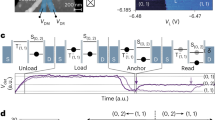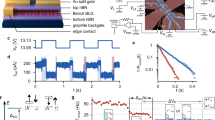Abstract
Valley pseudospin, the quantum degree of freedom characterizing the degenerate valleys in energy bands1, is a distinct feature of two-dimensional Dirac materials1,2,3,4,5. Similar to spin, the valley pseudospin is spanned by a time-reversal pair of states, although the two valley pseudospin states transform to each other under spatial inversion. The breaking of inversion symmetry induces various valley-contrasted physical properties; for instance, valley-dependent topological transport is of both scientific and technological interest2,3,4,5. Bilayer graphene is a unique system whose intrinsic inversion symmetry can be controllably broken by a perpendicular electric field, offering a rare possibility for continuously tunable topological valley transport. We used a perpendicular gate electric field to break the inversion symmetry in bilayer graphene, and a giant nonlocal response was observed as a result of the topological transport of the valley pseudospin. We further showed that the valley transport is fully tunable by external gates, and that the nonlocal signal persists up to room temperature and over long distances. These observations challenge the current understanding of topological valley transport in a gapped system, and the robust topological transport may lead to future valleytronic applications.
This is a preview of subscription content, access via your institution
Access options
Subscribe to this journal
Receive 12 print issues and online access
$259.00 per year
only $21.58 per issue
Buy this article
- Purchase on SpringerLink
- Instant access to full article PDF
Prices may be subject to local taxes which are calculated during checkout




Similar content being viewed by others
References
Xu, X., Yao, W., Xiao, D. & Heinz, T. F. Spin and pseudospins in layered transition metal dichalcogenides. Nature Phys. 10, 343–350 (2014).
Xiao, D., Yao, W. & Niu, Q. Valley-contrasting physics in graphene: Magnetic moment and topological transport. Phys. Rev. Lett. 99, 236809 (2007).
Mak, K. F., McGill, K. L., Park, J. & McEuen, P. L. The valley Hall effect in MoS2 transistors. Science 344, 1489–1492 (2014).
Gorbachev, R. V. et al. Detecting topological currents in graphene superlattices. Science 346, 448–451 (2014).
Xiao, D., Liu, G.-B., Feng, W., Xu, X. & Yao, W. Coupled spin and valley physics in monolayers of MoS2 and other group-VI dichalcogenides. Phys. Rev. Lett. 108, 196802 (2012).
Xiao, D., Chang, M.-C. & Niu, Q. Berry phase effects on electronic properties. Rev. Mod. Phys. 82, 1959–2007 (2010).
Nagaosa, N., Sinova, J., Onoda, S., MacDonald, A. H. & Ong, N. P. Anomalous Hall effect. Rev. Mod. Phys. 82, 1539–1592 (2010).
Abanin, D. A. et al. Giant nonlocality near the Dirac point in graphene. Science 332, 328–330 (2011).
Hoffmann, A. Spin Hall effects in metals. IEEE Trans. Magn. 49, 5172–5193 (2013).
Balakrishnan, J., Kok Wai Koon, G., Jaiswal, M., Castro Neto, A. H. & Özyilmaz, B. Colossal enhancement of spin–orbit coupling in weakly hydrogenated graphene. Nature Phys. 9, 284–287 (2013).
Wang, Z., Tang, C., Sachs, R., Barlas, Y. & Shi, J. Proximity-induced ferromagnetism in graphene revealed by the anomalous Hall effect. Phys. Rev. Lett. 114, 016603 (2015).
Yao, W., Xiao, D. & Niu, Q. Valley-dependent optoelectronics from inversion symmetry breaking. Phys. Rev. B 77, 235406 (2008).
Wu, S. et al. Electrical tuning of valley magnetic moment through symmetry control in bilayer MoS2 . Nature Phys. 9, 149–153 (2013).
Wang, L. et al. One-dimensional electrical contact to a two-dimensional material. Science 342, 614–617 (2013).
Zhang, Y. et al. Direct observation of a widely tunable bandgap in bilayer graphene. Nature 459, 820–823 (2009).
Zou, K. & Zhu, J. Transport in gapped bilayer graphene: The role of potential fluctuations. Phys. Rev. B 82, 081407 (2010).
Taychatanapat, T. & Jarillo-Herrero, P. Electronic transport in dual-gated bilayer graphene at large displacement fields. Phys. Rev. Lett. 105, 166601 (2010).
Abanin, D. A., Shytov, A. V., Levitov, L. S. & Halperin, B. I. Nonlocal charge transport mediated by spin diffusion in the spin Hall effect regime. Phys. Rev. B 79, 035304 (2009).
Decker, R. et al. Local electronic properties of graphene on a BN substrate via scanning tunneling microscopy. Nano Lett. 11, 2291–2295 (2011).
Xue, J. et al. Scanning tunnelling microscopy and spectroscopy of ultra-flat graphene on hexagonal boron nitride. Nature Mater. 10, 282–285 (2011).
Engels, S. et al. Limitations to carrier mobility and phase-coherent transport in bilayer graphene. Phys. Rev. Lett. 113, 126801 (2014).
Couto, N. J. G. et al. Random strain fluctuations as dominant disorder source for high-quality on-substrate graphene devices. Phys. Rev. X 4, 041019 (2014).
Wu, S., Yang, R., Shi, D. & Zhang, G. Identification of structural defects in graphitic materials by gas-phase anisotropic etching. Nanoscale 4, 2005–2009 (2012).
König, M. et al. Quantum spin Hall insulator state in HgTe quantum wells. Science 318, 766–770 (2007).
Roth, A. et al. Nonlocal transport in the quantum spin Hall state. Science 325, 294–297 (2009).
Bernevig, B. A., Hughes, T. L. & Zhang, S.-C. Quantum spin Hall effect and topological phase transition in HgTe quantum wells. Science 314, 1757–1761 (2006).
Yao, W., Yang, S. A. & Niu, Q. Edge states in graphene: From gapped flat-band to gapless chiral modes. Phys. Rev. Lett. 102, 096801 (2009).
Li, J., Martin, I., Büttiker, M. & Morpurgo, A. F. Topological origin of subgap conductance in insulating bilayer graphene. Nature Phys. 7, 38–42 (2011).
Alden, J. S. et al. Strain solitons and topological defects in bilayer graphene. Proc. Natl Acad. Sci. USA 110, 11256–11260 (2013).
Lensky, Y. D., Song, J. C. W., Samutpraphoot, P. & Levitov, L. S. Topological valley currents in gapped Dirac materials. Phys. Rev. Lett. 114, 256601 (2015).
Liu, X.-J., Liu, X. & Sinova, J. Scaling of the anomalous Hall effect in the insulating regime. Phys. Rev. B 84, 165304 (2011).
Burkov, A. A. & Balents, L. Anomalous Hall effect in ferromagnetic semiconductors in the hopping transport regime. Phys. Rev. Lett. 91, 057202 (2003).
Lyanda-Geller, Y. et al. Charge transport in manganites: Hopping conduction, the anomalous Hall effect, and universal scaling. Phys. Rev. B 63, 184426 (2001).
Shimazaki, Y. et al. Generation and detection of pure valley current by electrically induced Berry curvature in bilayer graphene. Preprint at http://arxiv.org/abs/1501.04776 (2015).
Taychatanapat, T., Watanabe, K., Taniguchi, T. & Jarillo-Herrero, P. Quantum Hall effect and Landau-level crossing of Dirac fermions in trilayer graphene. Nature Phys. 7, 621–625 (2011).
Lindvall, N., Kalabukhov, A. & Yurgens, A. Cleaning graphene using atomic force microscope. J. Appl. Phys. 111, 064904 (2012).
Acknowledgements
We thank Q. Niu, D.-H. Lee, F. Wang, J. Shi, J. Xiao, P. Kim and J. Zhu for helpful discussions. Part of the sample fabrication was performed at the Fudan Nano-fabrication Lab. M.S., G.C., L.M. and Y.Z. acknowledge the financial support of the National Basic Research Program of China (973 Program) under grant nos 2013CB921902 and 2011CB921802, and NSF of China under grant nos 11034001 and 11425415. W.Y. acknowledges support from the University of Hong Kong (OYRA), and the RGC of Hong Kong SAR (HKU706412P). W.-Y.S. and D.X. acknowledge support from the US Department of Energy, Office of Science, Office of Basic Energy Science, under award no. DE-SC0012509. D.T. and X.J. are supported by MOST (grants no. 2015CB921400 and no. 2011CB921802) and NSF of China (grants no. 11374057, no. 11434003 and no. 11421404). K.W. and T.T. acknowledge support from the Elemental Strategy Initiative conducted by the MEXT, Japan. T.T. acknowledges support from Grant-in-Aid for Scientific Research (Grant 262480621) and Innovative Areas ‘Nano Informatics’ (Grant 25106006) from JSPS.
Author information
Authors and Affiliations
Contributions
M.S. fabricated the samples, carried out the measurements, and analysed the data. G.C. helped with sample fabrication. L.M. helped with electrical measurements. W.-Y.S. and D.T. helped with data analysis. K.W. and T.T. grew hBN crystals. Y.Z., D.X., W.Y. and X.J. co-supervised the project. All authors contributed to the writing of the manuscript.
Corresponding author
Ethics declarations
Competing interests
The authors declare no competing financial interests.
Supplementary information
Supplementary information
Supplementary information (PDF 2137 kb)
Rights and permissions
About this article
Cite this article
Sui, M., Chen, G., Ma, L. et al. Gate-tunable topological valley transport in bilayer graphene. Nature Phys 11, 1027–1031 (2015). https://doi.org/10.1038/nphys3485
Received:
Accepted:
Published:
Issue date:
DOI: https://doi.org/10.1038/nphys3485
This article is cited by
-
Inheritance of the exciton geometric structure from Bloch electrons in two-dimensional layered semiconductors
Frontiers of Physics (2024)
-
Time-reversal even charge hall effect from twisted interface coupling
Nature Communications (2023)
-
Quantized valley Hall response from local bulk density variations
Communications Physics (2023)
-
Strain engineering of electronic properties and anomalous valley hall conductivity of transition metal dichalcogenide nanoribbons
Scientific Reports (2022)
-
Robust all-electrical topological valley filtering using monolayer 2D-Xenes
npj 2D Materials and Applications (2022)



